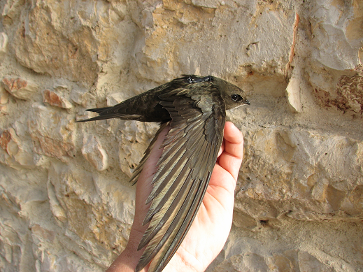Swifts, the birds that symbolise summer, travel 20,000 kilometres on their migratory journey to Africa
We now know where our common swifts overwinter, this was a great mystery up until just five years ago because we did not have the data that geolocators can now provide. These devices have allowed us to discover much more about this species, which is a much-loved part of our summer skies.

A total of 41 common swifts have been tagged in this area since 2012 and of these, 11 have been recaptured to reveal their spectacular journey.
Common swifts are some of the birds that best represent our towns and cities in the spring. Every year, from March onwards, thousands of birds crowd our skies with their characteristic calls and then at the end of July they begin to abandon their nests and head towards Africa.
The swifts of Nuevo Baztán
SEO/BirdLife, in collaboration with the Fundación Iberdrola España and as part of the Migra programme, began tagging the first common Swifts in Spain in 2012. The birds that came to the Madrid municipality of Nuevo Baztán were marked in order to discover where they overwintered and the routes they took as part of their migration.
It all started in a building that is part of the complex of buildings that includes Goyeneche Palace, which is a Historical Artistic Monument and an Asset of Cultural Interest. The building dates from the beginning of the 18th century and it was remodelled and adapted by an enthusiastic nature-lover, Enrique Navarro, to facilitate the breeding of the species. The palace was named in honour of Juan de Goyeneche y Gaston (1656-1735), a 17th century journalist and politician, who developed the industrial complex that later gave rise to the current municipal area of Nuevo Baztán.
A total of 41 common swifts have been tagged in this area since 2012 and of these, 11 have been recaptured to reveal their spectacular journey. Nuevo Baztán municipal council have collaborated in the work undertaken to capture and then recapture the birds.
A migratory journey of 20,000 km
‘Goyeneche’ was the first swift to reveal the complete journey involved in the swifts’ migration outside of the breeding season. There have also been others, such as ‘Baztán’, ‘Trufa’, ‘Espiga’ and ‘Berto’ who have provided more details on the Spanish swifts’ overwintering areas and the migration of this most energetic of birds, which only lands to breed.
The swifts leave their breeding areas in Spain in autumn to migrate across continental Africa where they skirt around the Sahara desert by flying along the Atlantic coast. They cross the Sahel to arrive at their first overwintering area located on the border between Cameroon and the Democratic Republic of the Congo. The area is made up of large areas of forests and savannah and they reach it after travelling more than 9,000 kilometres from their nests. “In December they move to a second overwintering area, further to the east, near the coasts of Tanzania, Kenya and Mozambique” says Bermejo Ana, a technician in SEO/BirdLife’s Bird Tracking and Study Department and one of the programme managers.
In February, they leave their overwintering areas to cross Africa, the Gulf of Guinea and the Sahara desert to reach their summer breeding area in Spain. They arrive in early May after more than 11,000 kilometres and a three-month return trip. In total, this is a trip of more than 20,000 kilometres from the villages of the Iberian peninsula to the African jungles and savannah.
The historic city walls of Lugo and the Frontón de Irún sports area are two other locations where the migration of the common swift is being studied. Between 2012 and 2016, SEO/BirdLife has marked 131 swifts throughout the Spanish territory, including in: Ciudad Real, Córdoba, Guipúzcoa, León, Lugo and Madrid, of these we have recaptured 39 birds. In 2017, we will continue exploring the migratory journeys of this bird, which weighs just 40 grams, by tagging more birds with geolocators.
This long journey is not without dangers and threats, many of them natural, such as geographical barriers, the weather, predators, or the search for food and shelter in the resting areas. But in recent decades, migratory birds have had to face additional dangers arising from presence and activity of the man: changes to or the destruction of their habitat, illegal hunting, overhead power lines, wind turbines, poison, climate change to name but a few.
All this means that bird migratory patterns are changing. The birds are adapting to the emerging changes, both natural and man-made. This is one reason it is so important to find out about their migration routes and destinations in Africa so as to be able to eliminate these threats wherever possible. Detailed information about these incredible journeys can be found on www.migraciondeaves.org
Migra programme
The Migra programme, was launched in 2011 by SEO/BirdLife in partnership with Fundación Iberdrola España, incorporating the latest geolocation and remote-monitoring technologies to learn about bird movements in greater detail, both within Spain and beyond.
This technology enables us to ascertain their migratory start and end dates, the places where they stop and their feeding points, the time it takes them to make these journeys, whether the same paths are repeated in spring and autumn migrations, the main areas where they overwinter and disperse, and whether the routes are the same year after year.
The Migra programme currently has 783 tagged birds, from 32 different species, of these 447 birds from 31 species have provided useful information. The programme has more than 300 collaborators and 50 affiliate organisations in Spain and abroad.
